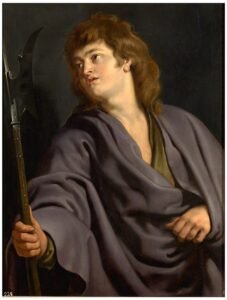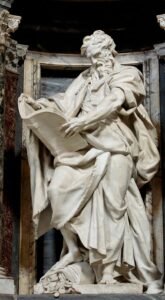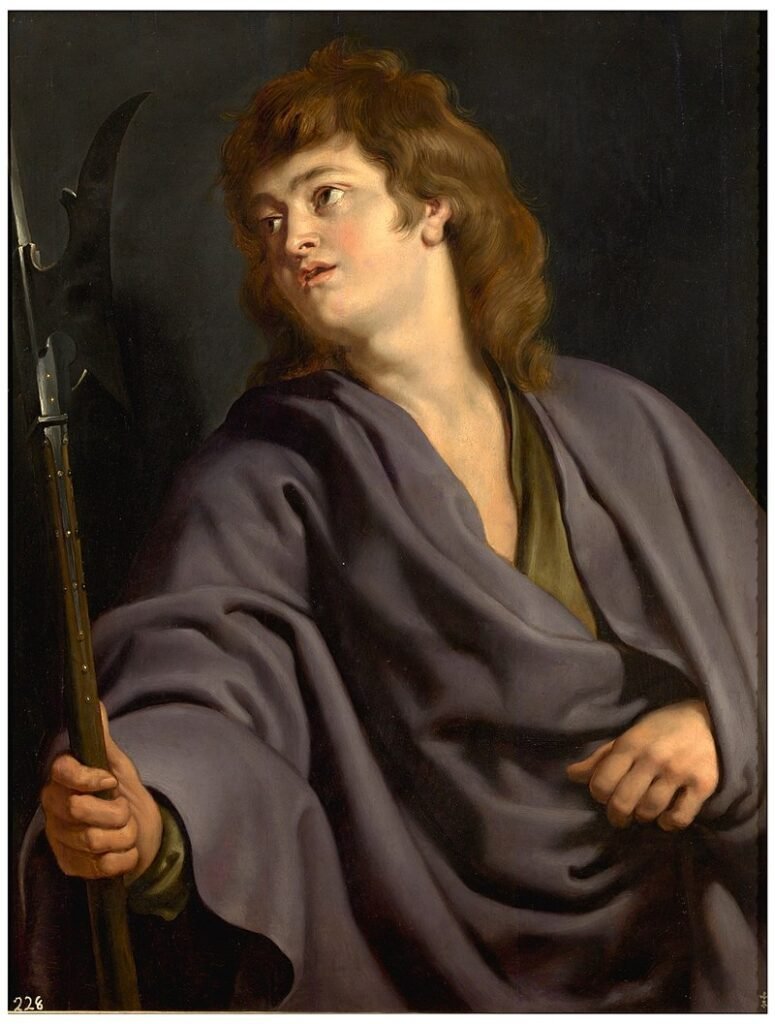Uncover 20 Facts About St Matthew: The Riveting Story Behind Saint Matthew
As we explore 20 Facts About St Matthew, one thing becomes clear – this apostle and gospel writer led an incredible life of faith. Digging into 20 Facts About St Matthew illuminates the background and journey of a tax collector transformed into sainthood.
Born around the same time as Jesus Christ, Matthew went from a sinful profession to becoming one of the twelve apostles who walked closely with the Savior. His eyewitness account of Jesus’ ministry, death, and resurrection is preserved in the Gospel of Matthew, the first book of the New Testament. Beyond authoring this important gospel, Matthew traveled extensively to share the good news of Jesus Christ.
From these 20 facts about St Matthew, we gain insightful perspectives on the call to discipleship and the power of repentance. Even a tax collector scorned by society could become a revered saint when transformed by responding to Jesus’ call. As we open our hearts and minds, may these 20 facts about St Matthew bring each of us closer to Christ.

What are 20 Facts About St Matthew?
Through this blog post, we will go into detail about Saint Matthew, including how to make a Catholic Pilgrimage to see him in person so you can grow in your love for him. However, here are 20 quick facts about his incredible apostle and saint.
1. Tradition holds that St. Matthew was one of the four Evangelists and authored the first Gospel, conveying Christ’s life and lessons.
2. Before following Jesus, Matthew worked as a tax collector, making him one of the earliest disciples plucked from a secular path.
3. As a tax collector, Matthew would have been seen as an outcast and sinner. Yet Christ embraced him, changing his heart.
4. Jesus encountering Matthew at work is depicted in the famous painting The Calling of St. Matthew by Caravaggio.
5. St. Matthew is recognized as the patron saint of bankers, tax collectors and accountants. His former profession no doubt aids him in guiding those workers.
6. He is also patron of customs officers and security guards, as he protected the money he collected before finding his higher calling.
7. The Apostle Matthew is symbolized in Christian art by three bags of coins or money pouches, representing his tax collecting past.
8. Like the other apostles, St. Matthew was a missionary who spread the good news of Christ’s Gospel message around the Mediterranean after the Ascension.
9. Ancient texts record him traveling to places like Macedonia, Syria and Persia, where he founded Christian churches before his martyrdom.
10. St. Matthew is believed to have been martyred in Ethiopia while ministering there. Accounts differ on whether he was stabbed, beheaded, or burned alive.
11. September 21st honors St. Matthew with a feast day commemorating his pious life of unwavering evangelism and faith in the face of persecution.
12. In the early church, the Gospel of Matthew was placed first in collections of New Testament texts in honor of its authorship by the apostle.
13. The name Matthew comes from Hebrew and means “gift of God.” His Gospel records Jesus referring to him as this gift when he called him to discipleship.
14. St. Matthew Cathedral in Washington D.C. contains a shrine with relics of St. Matthew gifted in the 19th century by Pope Pius IX.
15. St. Matthew is often depicted in religious art as an older man with a beard, holding a pen and book to acknowledge his Gospel authorship.
16. Because he spread the faith abroad to many lands, St. Matthew is the patron saint of travelers and vacationers who journey far from home.
17. As one of the apostles present at the Last Supper, St. Matthew experienced firsthand many pivotal moments of Christ’s ministry.
18. Some scholarship suggests St. Matthew and the tax collector Levi mentioned in the Gospels may have been the same person.
19. St. Matthew’s original tomb is believed to have been in Salerno, Italy. In the 11th century his relics were brought to the Salerno Cathedral.
20. The saint’s life story reminds us that Christ can call us to serve His divine purpose at any point in our journey if we open our hearts.
Who was St. Matthew?
St. Matthew, also known as Levi, was one of the twelve apostles of Jesus Christ and the traditional author of the first gospel account of the life of Jesus. Matthew worked as a tax collector in Capernaum before becoming an apostle. His gospel provides important details about Jesus’s birth, ministry, death, and resurrection. As we explore 20 facts about St Matthew, we’ll learn more about his background, his calling as an apostle, his gospel, and his legacy in the early Christian church.
When did St. Matthew live?
St. Matthew lived during the 1st century AD. He was born around the same time as Jesus, between 6 and 4 BC. Jesus began his public ministry around AD 27-29 when he was “about thirty years of age” (Luke 3:23). Matthew would have been around the same age when he encountered Jesus and decided to follow him. Most scholars believe Matthew wrote his gospel account sometime between AD 80-90. So while his early life coincided with Jesus’s life and ministry, the writing of his gospel came later in his life. Getting a better understanding of when St. Matthew lived helps us appreciate the world he inhabited and how the early Christian church took shape.
What was St. Matthew’s occupation before becoming an apostle?
St. Matthew worked as a tax collector in Capernaum before becoming an apostle of Jesus. In the Roman empire, tax collectors were seen as corrupt and despised by the Jewish people. This was because tax collectors could charge excess fees and often abused their power. Yet despite his sinful past, Jesus saw Matthew’s potential and called him specifically to be an apostle. Matthew’s experience as a tax collector likely helped him develop administrative skills that assisted in his work of spreading the gospel and building the early church.
How did St. Matthew become one of Jesus’s 12 apostles?
According to the Gospel accounts, Matthew was sitting at his tax collector’s booth in Capernaum when Jesus approached him and said “Follow me.” Without delay, Matthew got up and followed him. Jesus later appointed him as one of the twelve apostles. Choosing Matthew, a sinful tax collector, showed Jesus’s willingness to call anyone to follow him, regardless of background or social status. Matthew recognized that Jesus saw value in him despite his past. This encounter was so profound that Matthew immediately left his work to become a disciple of Christ.
What gospel did St. Matthew write?
St. Matthew wrote the first gospel account that appears in the New Testament. His account begins with Jesus’s genealogy and birth, then covers his ministry, teaching, miracles, death on the cross, resurrection, and commissioning of the apostles to spread the good news. Matthew organized his account in a structured and concise way. The book emphasizes Jesus’s ministry to the Jews and presents him as the Messiah who fulfilled Old Testament prophecies. Matthew’s gospel is one of the most cited New Testament books in early Christian writings.
What are some key events in the life of Jesus that St. Matthew wrote about?
Some key events in Jesus’s life that Matthew recorded in his gospel account include:
– Jesus’s virgin birth to Mary in Bethlehem
– Jesus’s baptism by John the Baptist
– The Sermon on the Mount where Jesus gave his central teachings
– Many of Jesus’s miracles, including healing lepers and the blind, feeding the 5000, and walking on water
– The Transfiguration when Jesus’s appearance changed on a mountain
– Jesus’s triumphal entry into Jerusalem on Palm Sunday
– The Last Supper where Jesus instituted Communion
– Jesus’s death by crucifixion on Good Friday
– His resurrection from the dead on Easter Sunday
– The Great Commission sending his disciples out to make disciples of all nations
These events provided eyewitness testimony and underscored Jesus’s identity and mission as the promised Messiah.
Where did St. Matthew do most of his missionary work?
After Jesus’s ascension into heaven, St. Matthew went on missionary journeys to share the gospel, primarily throughout Judea and Syria. There are also early church writings that mention Matthew traveling to places like Persia, Parthia, Ethiopia and Macedonia, but these accounts are uncertain. He definitely focused his earlier efforts on spreading the faith to Jewish communities. And the early church fathers often mention him preaching in Judea, and particularly its capital Jerusalem, where the church first took root.
How did St. Matthew die?
There are conflicting accounts of how St. Matthew died. The most widely accepted tradition is that Matthew died as a martyr, killed with a halberd (a battle axe on a pole) while ministering in Ethiopia. Other early church accounts say he died of natural causes either in Ethiopia or in Macedonia. Many of the traditional martyrdom stories cannot be verified. But there’s agreement Matthew died serving the Lord, whether through martyrdom or natural causes, after a life devoted to spreading the gospel.
What is St. Matthew the patron saint of?
Given his past work as a tax collector, St. Matthew is fittingly the patron saint of bankers, bookkeepers, accountants, tax collectors, and financial workers. He’s also the patron saint of the diocese of San Mateo in California. People working with financial matters can look to Matthew as an example of how to serve God faithfully and use money and resources ethically. His gospel also emphasizes the importance of upholding and teaching God’s law, so he is a patron saint of lawyers and civil servants as well.
What symbols is St. Matthew associated with?
In art, St. Matthew is often depicted with the following symbols:
– Wings: Symbolize Matthew’s divine inspiration in writing his gospel.
– Quill and book: Represent the fact he authored a gospel account.
– Bag of coins: Recall his work as a tax collector before following Christ.
– Spear or halberd: Allude to the tradition he was martyred with this weapon.
– Carpet: Matthew is sometimes painted standing or sitting on a carpet symbolizing his adherence to the truth.
– Angel/man: Matthew begins his gospel with Jesus’s human genealogy and birth.
These symbols help visually communicate Matthew’s life, identity and key themes from his gospel writing.
What are some interesting or little-known facts about St. Matthew?
Here are some fascinating details about St. Matthew that not everyone may be aware of:
– Matthew’s gospel contains many references and allusions to Old Testament scripture and prophecy. This emphasizes Jesus’s role in fulfilling the Messianic prophecies.
– The three Magi who visited the young Jesus after his birth appear only in Matthew’s gospel account.
– Matthew is the only gospel writer to refer to the “church” using the Greek word ekklesia.
– Matthew quotes Jesus using the phrase “kingdom of heaven” rather than “kingdom of God” found in the other gospels.
– Although a Jew himself, Matthew’s gospel seems intended for a Greek or Jewish-Christian audience based on its structure and content.
– According to early church tradition, the resurrected Jesus appeared first to Matthew in Galilee on a mountaintop.
– Before naming the 12 apostles, Jesus went alone to a mountainside to pray all night, indicating the important decision he was about to make.
Exploring these interesting details provides a fuller picture of this prominent yet still somewhat enigmatic apostle and early church leader.
Who was St. Matthew?
Reviewing St. Matthew’s background, we’re reminded that he worked as a tax collector in Capernaum before becoming an apostle. Jesus saw Matthew’s potential, called him to be a disciple, and later appointed him as one of the twelve apostles. Matthew left a lucrative business behind to follow Christ immediately and faithfully.
When did St. Matthew live?
We learned that St. Matthew lived during the 1st century AD at the time of Jesus Christ’s earthly ministry. He was born around the same time as Jesus, between 6 and 4 BC. Most scholars believe Matthew wrote his gospel account between AD 80-90, drawing from decades of reflection on Jesus’s life and teaching.
What was St. Matthew’s occupation before becoming an apostle?
St. Matthew worked as a tax collector in Capernaum before Jesus called him to be an apostle. As a tax collector, Matthew would have been scorned and viewed as corrupt. But Jesus focused on Matthew’s heart not his past sins.
How did St. Matthew become one of Jesus’s 12 apostles?
The Gospel accounts tell us that Jesus approached Matthew as he was sitting at his tax collector’s booth and simply said “Follow me.” Matthew immediately got up, left everything, and followed Jesus. Later, Jesus chose him to be one of the twelve apostles.
What gospel did St. Matthew write?
St. Matthew wrote the first gospel account presented in the New Testament. His account provides important details about Jesus’s birth, ministry, miracles, teaching, death, resurrection, and commissioning of his disciples.
What are some key events in the life of Jesus that St. Matthew wrote about?
Some key events described in Matthew’s gospel include Jesus’s virgin birth, baptism by John, the Sermon on the Mount, his miracles, the Transfiguration, the triumphal entry, the Last Supper, his crucifixion and resurrection, and the Great Commission. Matthew focused largely on recounting the life and ministry of Jesus.

Where did St. Matthew do most of his missionary work?
After Jesus’s ascension, Matthew traveled extensively sharing the gospel message. He focused especially on Jewish communities in Judea and Syria. Church tradition also suggests he may have traveled to Persia, Ethiopia and Macedonia, but these accounts are uncertain.
How did St. Matthew die?
The circumstances of St. Matthew’s death are unclear. One tradition says he was martyred in Ethiopia. Other accounts say he died of natural causes in Ethiopia or Macedonia. But Matthew clearly devoted his life after Christ’s ascension to spreading the gospel around the known world.
What is St. Matthew the patron saint of?
Given his background as a tax collector, St. Matthew fittingly became known as the patron saint of bankers, bookkeepers, accountants, tax collectors, and financial workers. His gospel’s emphasis on law also led to him being named as a patron saint of lawyers and civil servants.
What symbols is St. Matthew associated with?
Common symbols representing St. Matthew include wings, a book or gospel, bag of coins, spear, carpet, and an angel/man. These symbols point to his divine inspiration, gospel authorship, past profession, martyrdom tradition, truthfulness, and the human/divine nature of Jesus.
What are some interesting or little-known facts about St. Matthew?
Some fascinating details about St. Matthew include his many Old Testament references in his gospel, his unique reporting on the Magi and the “church”, his use of “kingdom of heaven”, the intended audience of his gospel, Jesus appearing first to him after the resurrection, and Jesus praying before choosing the twelve apostles.
In this extensive exploration of St. Matthew, we’ve uncovered details about his background, life, apostolic calling, gospel authorship, ministry, symbols, patronage, and more. Studying these 20 facts provides a deeper appreciation for this prominent apostle, gospel writer, and saint who helped build the foundations of the early Christian church. As one of the twelve apostles, Matthew left an invaluable written testimony and legacy for believers throughout the centuries.
How can I make a Catholic Pilgrimage to see St. Matthew?
Going on a pilgrimage to sites connected to saints is an ancient and meaningful tradition in Catholicism. As we strive to grow closer to God, walking in the physical footsteps of holy men and women who have gone before us can deepen faith and inspire righteous living. If you feel called to embark on a pilgrimage to honor St. Matthew, there are a few locations that offer spiritual pilgrims places associated with this apostle and evangelist.
The main pilgrimage site is located in Salerno, Italy where the remains of St. Matthew are preserved in the Salerno Cathedral. Built in the 11th century, the cathedral’s crypt houses the apostle’s body which was transported here in the 10th century. Pilgrims can visit the crypt, view St. Matthew’s remains, and celebrate Mass in this holy shrine. Most pilgrimages focus on Salerno to be near the bodily relics of St. Matthew.
In addition, the site of the ancient tax collector’s booth where Jesus called St. Matthew in Capernaum, Israel provides another opportunity for prayerful pilgrimage. Visitors can reflect on Matthew’s conversion at this historic site along the Sea of Galilee. Whether journeying to Salerno or Capernaum, pilgrims invite spiritual blessings by walking in the footsteps of this holy apostle.
I’ve explored the entire city. I have traveled to a number of nations, including the United States, Canada, Scotland, Korea, Hong Kong, Macau, The Vatican, Switzerland, France, Milan, Turkey, and the entire state of Israel.
I am well-versed in all facets of travel. To assist you in getting ready for your vacation, I’ve provided you with a few basic tools.
- Find cheap flights for your journey HERE
- A Car Rental
- Taxi Drivers
- Bus or Train Tickets
- Choose the Perfect Hotel for Your Trip HERE
- Fun Events for Your Journey
- Travel Insurance
- Phone for Traveling
Time to pack your bags! 🙂
Making Travel Arrangements to See St. Matthew
Once you’ve decided to undertake a pilgrimage to a holy site related to St. Matthew, it’s time to make the necessary travel arrangements. If traveling to Salerno, Italy, you’ll need to book international flights into Naples, which is just 30 miles from Salerno. Or consider traveling to Rome first before heading south to Salerno. Booking rooms at hotels close to the Cathedral of Salerno will provide convenience and save time.
When visiting Capernaum in Israel, secure travel visas as needed and book flights into Tel Aviv. Rent a car or join a Christian tour group to travel easily to Capernaum in Galilee. Finding hotel rooms in the small town of Tiberias on the Sea of Galilee makes a good base for side trips to Capernaum and other Galilean sites. Whether journeying to Italy or Israel, smart planning reduces hassle and frees you to focus on spiritual blessings.
As you research flights, lodging, and transportation, remember flexibility allows you to follow any spiritual nudges that arise. While advance planning is key, be open to changing course based on prayer and discernment during your pilgrimage travels.
How can going on a Catholic pilgrimage to see St. Matthew help to make me a saint?
The main value of a pilgrimage is growing closer to God by following the example set by holy men and women who have gone before us. In the case of St. Matthew, we see his obedience in responding immediately to Christ’s call. We witness his repentance from a sinful past to embrace discipleship. In Matthew’s gospel account, we learn directly from an apostle who walked closely with Jesus.
By traveling prayerfully to trace St. Matthew’s journey, we open ourselves to being shaped and molded by his saintly witness. As we encounter sites like the tax collector’s post or the crypt housing his remains, we prayerfully reflect on St. Matthew’s sanctified life. Our perspective expands and our priorities align more closely with the kingdom of God. Our faith is enriched by walking in the footsteps of saints from long ago.
The blessings that flow from an intentional pilgrimage reinforce our progress on the lifelong path to sanctity. Along the way we may experience challenges or hardships that increase patience and hope. By making a pilgrimage to honor St. Matthew, we spur our spiritual growth while praising God for the example set by His saints.
Conclusion
How has knowing about the 20 Facts About St Matthew affected your motivation or sense of inspiration? Biographies of saints are fascinating to read and discuss. It’s quite likely to produce spiritual benefits in our life.
Do you want to have a quick conversation with your loved ones about the saints? Would you mind purchasing one of these amazing shirts that I created just for you? You can use the search bar at the top of this page to seek up your favorite well-known saints. You can explain the lives of your favorite well-known saints in response to questions about the meaning of your attire from others.
They might even agree to go to church with you after hearing these inspirational stories. Even better, you could be able to tell them about Jesus. Are you proficient in sharing the gospel with others?
According to Romans 3:23, everyone has sinned and has fallen short of God’s glory. Because of this, everyone needs a Savior.
To make it possible for us to receive forgiveness, God sent His one and only son to fulfill the demands of the law. Romans 4:15–16
Jesus had to be born into sin, live a blameless life, and die in order to offer the fullest atonement for our sins. This is how the Bible puts it.
“Indeed, under the law almost everything is purified with blood, and without the shedding of blood there is no forgiveness of sins.”
– Hebrews 9:22
However, the story did not finish with Jesus’ crucifixion, execution, and burial. No, He resurrected himself! Because He is alive, He promises to raise us from the dead. He conquered death and sin. Praise be Jesus Christ!
Now that you have informed your family, friends, and acquaintances of this important information, invite them to the RCIA program at the local Catholic church.
Family members, friends, and acquaintances can use the Rite of Christian Initiation for Adults, or RCIA, to become eligible to receive the Holy Sacraments and become members of the Catholic Church. Through participation in RCIA sessions provided by their parish, students can acquire comprehensive information about our amazing Christian faith and our Kind Jesus.
This is the genuine method of saving a life. I’m making this wish for you.
Click HERE or on the image to view this 20 Facts About St Matthew T-shirt that was specially created for you. Choose your favorite size and color, then click the BUY NOW button to proceed to the payment page.
You can access a list of additional well-known saints from our website by clicking HERE.

Are you free to read about another saint now that you have read the 20 Facts About St Matthew?
Why not look into:
- St. Thérèse of Lisieux: Top 11 Joyful Spirituality Aspects of Her Shining Light for Our Times
- ‘Prayer for Our Mother of Perpetual Help’ – 11 Top Tips to This Inspiring Prayer that Will Reignite Your Devotion
- “Prayer to St Jude for Financial Help”: Are Your Finances in Crisis? 11 Top Tops to Restore Your Hope
- ‘St Therese Prayer Novena’: 14 Top Tips – Unlock Saintly Guidance Through this Little Way Novena
After learning about this 20 Facts About St Matthew, have you considered returning to this website each day to read more about the Saint of the Day? If you would like to receive my daily saint emails in your inbox, please take a moment to sign up. Since you already have a lot on your plate, I’ll keep it brief, but I’ll say more because I want you to take inspiration from me and always strive for improvement.
As a thank you, I’ll give you a free printable of Our Lady of Perpetual Help to hang in your home or place of business. As soon as you submit the form, I’ll send you an email containing a download link.
Enjoy!
Well, that’s all for today.
I’ll see you back tomorrow with another Saint of the Day to inspire you!
God bless you,
-Priscilla




